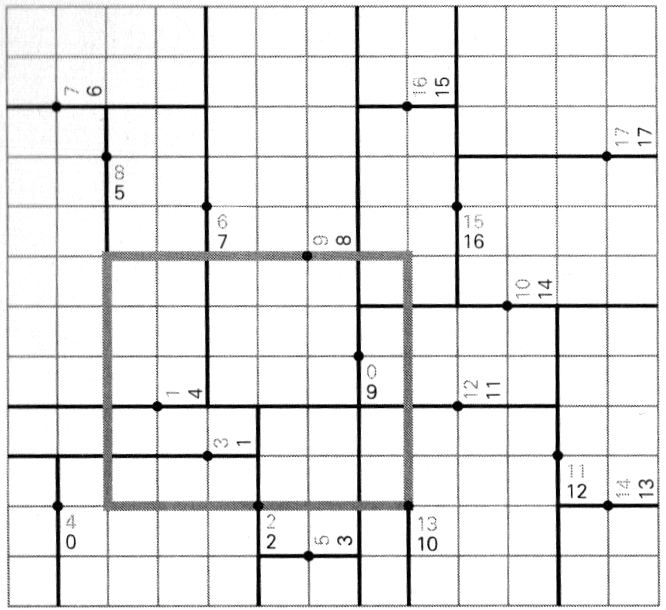范围搜索是从拥有多个属性的报表集合中,寻找具有特定属性且位于指定范围内的元素,这类问题被称为范围搜索。
我们在这里要解决的是二维的范围搜索问题。
在二维平面上给出一堆点,然后给出n个矩形框。要求输出在矩形框内的所有点的id。
kDtree其实就类似于二叉搜索树(嗯其实差不多就是二叉搜索树)。
题目是 DSL_2_C
我们需要建立2DTree,那就需要对x轴和y轴分别进行排序。实现方式就是,深度为偶数的时候以x轴为基准,深度为奇数时,以y轴为基准。

其实这就是二维分割,可以看作是把对一块大的平面区域进行分割,分别按照x轴和y轴来切一刀,接着对于每个小区域都执行相同的分割。所有的点都在分割边上的时候,停止分割。分割其实就是建立了一个类似于二叉搜索树的东西。
上代码!
#include <cstdio>
#include <string.h>
#include <algorithm>
#include <vector>
using namespace std;
#define MAXN 500005
struct node
{
int parent, left, right;
int location; //对应point数组里面的元素的下标
};
class point
{
public:
int id, x, y;
point() {}
point(int id, int x, int y)
{
(*this).id = id;
(*this).x = x;
(*this).y = y;
}
bool operator<(const point &p) const
{
return id < p.id;
}
void print()
{
printf("%d\n", id);
}
};
int n;
point p[MAXN];
node nd[MAXN];
int node_counter = 0;
const int NIL = -1;
bool cmpX(const point &a, const point &b)
{
return a.x < b.x;
}
bool cmpY(const point &a, const point &b)
{
return a.y < b.y;
}
int make2Dtree(int left, int right, int depth)
{
if (left >= right)
return NIL;
int t = node_counter++;
if (depth % 2 == 0) //以x为基准对p升序排序
{
sort(p + left, p + right, cmpX);
}
else
{
sort(p + left, p + right, cmpY);
}
int mid = (left + right) / 2;
nd[t].location = mid;
nd[t].left = make2Dtree(left, mid, depth + 1);
nd[t].right = make2Dtree(mid + 1, right, depth + 1);
return t;
}
vector<point> ans;
void search(int u, const int &sx, const int &tx, const int &sy, const int &ty, int depth)
{
int x = p[nd[u].location].x;
int y = p[nd[u].location].y;
if (x >= sx && x <= tx && y >= sy && y <= ty)
{
ans.push_back(p[nd[u].location]);
}
if (depth % 2 == 0)
{
if (nd[u].left != NIL)
{
if (sx <= x)
search(nd[u].left, sx, tx, sy, ty, depth + 1);
}
if (nd[u].right != NIL)
if (x <= tx)
search(nd[u].right, sx, tx, sy, ty, depth + 1);
}
else
{
if (nd[u].left != NIL)
if (sy <= y)
search(nd[u].left, sx, tx, sy, ty, depth + 1);
if (nd[u].right != NIL)
if (y <= ty)
search(nd[u].right, sx, tx, sy, ty, depth + 1);
}
}
int main()
{
scanf("%d", &n);
int x, y;
for (int i = 0; i < n; ++i)
{
scanf("%d%d", &x, &y);
p[i] = point(i, x, y);
nd[i].left = nd[i].right = nd[i].parent = NIL;
}
int root = make2Dtree(0, n, 0);
int q;
scanf("%d", &q);
int sx, tx, sy, ty;
for (int i = 0; i < q; ++i)
{
ans.clear();
scanf("%d%d%d%d", &sx, &tx, &sy, &ty);
search(root, sx, tx, sy, ty, 0);
sort(ans.begin(), ans.end());
for (point tmp : ans)
tmp.print();
//for(int i=0;i<ans.size();i++)
// ans[i].print();
printf("\n");
}
}转载请注明原文链接:https://www.longjin666.top/?p=752
欢迎关注我的公众号“灯珑”,让我们一起了解更多的事物~




